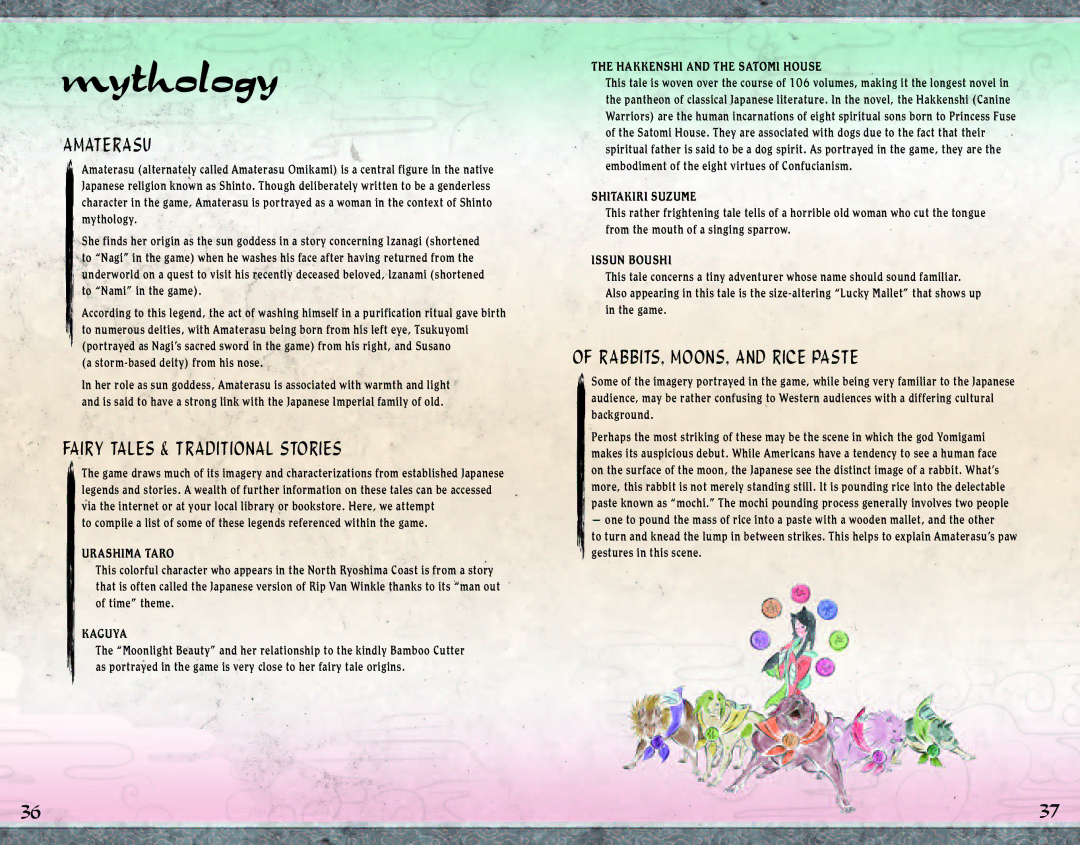
mythology
AMATERASU
Amaterasu (alternately called Amaterasu Omikami) is a central figure in the native Japanese religion known as Shinto. Though deliberately written to be a genderless character in the game, Amaterasu is portrayed as a woman in the context of Shinto mythology.
She finds her origin as the sun goddess in a story concerning Izanagi (shortened to “Nagi” in the game) when he washes his face after having returned from the underworld on a quest to visit his recently deceased beloved, Izanami (shortened to “Nami” in the game).
According to this legend, the act of washing himself in a purification ritual gave birth to numerous deities, with Amaterasu being born from his left eye, Tsukuyomi (portrayed as Nagi’s sacred sword in the game) from his right, and Susano
(a storm-based deity) from his nose.
In her role as sun goddess, Amaterasu is associated with warmth and light and is said to have a strong link with the Japanese Imperial family of old.
FAIRY TALES & TRADITIONAL STORIES
The game draws much of its imagery and characterizations from established Japanese legends and stories. A wealth of further information on these tales can be accessed via the internet or at your local library or bookstore. Here, we attempt
to compile a list of some of these legends referenced within the game.
URASHIMA TARO
This colorful character who appears in the North Ryoshima Coast is from a story that is often called the Japanese version of Rip Van Winkle thanks to its “man out of time” theme.
KAGUYA
The “Moonlight Beauty” and her relationship to the kindly Bamboo Cutter as portrayed in the game is very close to her fairy tale origins.
THE HAKKENSHI AND THE SATOMI HOUSE
This tale is woven over the course of 106 volumes, making it the longest novel in the pantheon of classical Japanese literature. In the novel, the Hakkenshi (Canine Warriors) are the human incarnations of eight spiritual sons born to Princess Fuse of the Satomi House. They are associated with dogs due to the fact that their spiritual father is said to be a dog spirit. As portrayed in the game, they are the embodiment of the eight virtues of Confucianism.
SHITAKIRI SUZUME
This rather frightening tale tells of a horrible old woman who cut the tongue from the mouth of a singing sparrow.
ISSUN BOUSHI
This tale concerns a tiny adventurer whose name should sound familiar. Also appearing in this tale is the
OF RABBITS, MOONS, AND RICE PASTE
Some of the imagery portrayed in the game, while being very familiar to the Japanese audience, may be rather confusing to Western audiences with a differing cultural background.
Perhaps the most striking of these may be the scene in which the god Yomigami makes its auspicious debut. While Americans have a tendency to see a human face on the surface of the moon, the Japanese see the distinct image of a rabbit. What’s more, this rabbit is not merely standing still. It is pounding rice into the delectable paste known as “mochi.” The mochi pounding process generally involves two people
— one to pound the mass of rice into a paste with a wooden mallet, and the other
to turn and knead the lump in between strikes. This helps to explain Amaterasu’s paw gestures in this scene.
36 | 37 |
